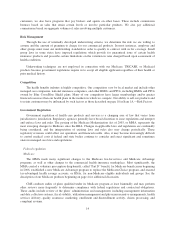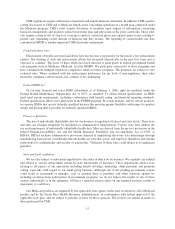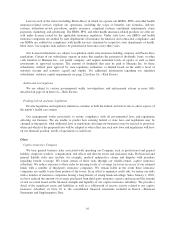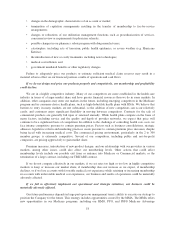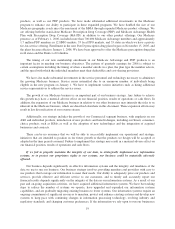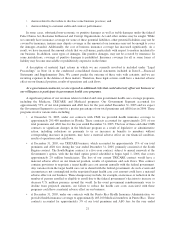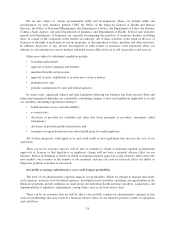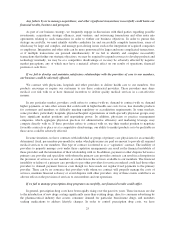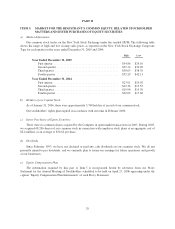Humana 2005 Annual Report Download - page 33
Download and view the complete annual report
Please find page 33 of the 2005 Humana annual report below. You can navigate through the pages in the report by either clicking on the pages listed below, or by using the keyword search tool below to find specific information within the annual report.Certain of our subsidiaries operate in states that regulate the payment of dividends, loans, or other cash
transfers to Humana Inc., our parent company, and require minimum levels of equity as well as limit investments
to approved securities. The amount of dividends that may be paid to Humana Inc. by these subsidiaries, without
prior approval by state regulatory authorities, is limited based on the entity’s level of statutory income and
statutory capital and surplus. In most states, prior notification is provided before paying a dividend even if
approval is not required.
As of December 31, 2005, we maintained aggregate statutory capital and surplus of $1,203.2 million in our
state regulated subsidiaries. Each of these subsidiaries was in compliance with applicable statutory requirements
which aggregated $722.2 million. Although the minimum required levels of equity are largely based on premium
volume, product mix, and the quality of assets held, minimum requirements can vary significantly at the state
level. Given our anticipated premium growth in 2006 resulting from the expansion of our Medicare products,
capital requirements will increase. We expect to fund these increased requirements with capital contributions
from Humana Inc., our parent company, in the range of $450 million to $650 million in 2006.
Most states rely on risk-based capital requirements, or RBC, to define the required levels of equity. RBC is a
model developed by the National Association of Insurance Commissioners to monitor an entity’s solvency. This
calculation indicates recommended minimum levels of required capital and surplus and signals regulatory
measures should actual surplus fall below these recommended levels. If RBC were adopted by all states and
Puerto Rico at December 31, 2005, we would be required to fund $14.7 million in one of our Puerto Rico
subsidiaries to meet all requirements. After this funding, we would have $378.2 million of aggregate capital and
surplus above any of the levels that require corrective action under RBC.
The use of individually identifiable data by our business is regulated at federal and state levels. These laws
and rules are changed frequently by legislation or administrative interpretation. Various state laws address the
use and maintenance of individually identifiable health data. Most are derived from the privacy provisions in the
federal Gramm-Leach-Bliley Act and HIPAA. HIPAA includes administrative provisions directed at simplifying
electronic data interchange through standardizing transactions, establishing uniform health care provider, payer,
and employer identifiers and seeking protections for confidentiality and security of patient data. The rules do not
provide for complete federal preemption of state laws, but rather preempt all inconsistent state laws unless the
state law is more stringent.
These regulations set standards for the security of electronic health information. Violations of these rules
will subject us to significant penalties. Compliance with HIPAA regulations requires significant systems
enhancements, training and administrative effort. HIPAA could also expose us to additional liability for
violations by our business associates. A business associate is a person or entity, other than a member of the work
force, who on behalf of a covered entity performs, or assists in the performance of a function or activity
involving the use or disclosure of individually identifiable health information, or provides legal, accounting,
consulting, data aggregation, management, administrative, accreditation, or financial services.
Another area receiving increased focus is the time in which various laws require the payment of health care
claims. Many states already have legislation in place covering payment of claims within a specific number of
days. However, due to provider groups advocating for laws or regulations establishing even stricter standards,
procedures and penalties, we expect additional regulatory scrutiny and supplemental legislation with respect to
claims payment practices. The provider-sponsored bills are characterized by stiff penalties for late payment,
including high interest rates payable to providers and costly fines levied by state insurance departments and
attorneys general. This legislation and possible future regulation and oversight could expose us to additional
liability and penalties.
We are implementing a mail order pharmacy business that subjects us to extensive federal, state and local
regulation. We are also subject to risks inherent in the packaging and distribution of pharmaceuticals and other
health care products.
23



